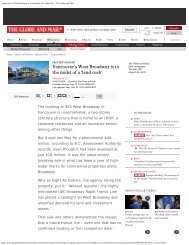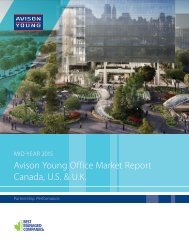Creativity
Creativity
Creativity
You also want an ePaper? Increase the reach of your titles
YUMPU automatically turns print PDFs into web optimized ePapers that Google loves.
Robert Landucci<br />
1. There are many industrial developers who will respond to the<br />
opportunities for smaller users. Properties will be redeveloped,<br />
older areas will undergo large transitions, innovation in space<br />
and need will come into the mix, and new distribution patterns<br />
will emerge. We have seen this trend for many years and it will<br />
continue. The economics will drive the change and square foot<br />
prices will increase.<br />
“Demand for alternate uses in urban land<br />
opportunities have forced changes in thinking ”<br />
2. Probably. But the question is, other than the real estate community<br />
and the retailers themselves looking for large-footprint buildings,<br />
does the Lower Mainland really want or need this kind of development?<br />
Some would suggest it is not in the long-term best interest<br />
of the transportation corridor, nor for the livability of the GVRD. Perhaps<br />
this demand should be looked at from a more holistic viewpoint.<br />
What does good sustainable demand look like in 2030?<br />
3. I don’t have a good idea of what Port Metro Vancouver is doing<br />
and what its full plan looks like so I can’t answer this question.<br />
4. It is important to look at alternatives before the ALR lands are<br />
considered. This is key. When old thinking, entrenched in false<br />
and staid assumptions, are used - mistakes will be made. This is<br />
happening today in the way other solutions are being assessed.<br />
The wealth of Canada is not created in the Lower Mainland, it is<br />
created in the mines, farms and small communities throughout<br />
BC and Canada that produce goods and sell them. We need to<br />
service them properly and keep costs low so they can compete<br />
globally. We should be looking at doing anything we can to move<br />
assembly and preparation closer to production sites and prepared<br />
for direct shipping to the docks.<br />
Why handle any product in the Lower Mainland if it doesn’t need<br />
to be handled here? The system works well for coal, wheat, potash<br />
and other commodities, why can’t it work for pulp, sawn lumber,<br />
retail goods, containers etc? It is no surprise that the urban growth<br />
in Asia and South America has caused tremendous challenges and<br />
has changed the life of millions of families. Is it for the better for<br />
them? Perhaps we can learn from what is happening in other areas<br />
and grow our economy in a manner that suits the average person.<br />
other comments:<br />
Not enough alternatives are being explored. As in other industries that<br />
have developed over the years, the demand for alternate uses in urban<br />
land opportunities have forced changes in thinking. For example:<br />
Coal harbour industries could not compete with office, hotel, retail and<br />
residential demand. The industries had to move or close. False Creek industry<br />
could not compete with the demand generated by Expo ‘86 and<br />
subsequent residential towers. Industry had to move or close. Granville<br />
Island could not compete with funky urban retail and grocery shopping<br />
trends. Industries had to move or close. Fraser River industries from New<br />
Westminster to Oak Street could not afford the land they were on. Industries<br />
had to move or close. Growth forces creative thinking for survival.<br />
There are many opportunities to service the retail distribution demand.<br />
The real question: Is it wise to do so on valuable urban lands with<br />
the retail and residential trends that are coming in the years ahead?<br />
Greg Wilks<br />
1. I think developers need to be flexible. The first phase of our<br />
Golden Ears Business Centre has changed more than half a dozen<br />
times as we work with the needs of the market in conjunction<br />
with our own goals. Due to the lack of industrial sites in Metro<br />
Vancouver, I think we will always have developers looking to accommodate<br />
the small and mid-sized users. Onni currently has<br />
about 1.9 (msf) of small bay warehousing spec product.<br />
2. I don’t think you can call it pressure. Perhaps the opportunity<br />
to accommodate large-scale warehousing has increased even<br />
though it would be hard to pinpoint a user willing to relocate in<br />
Metro Vancouver primarily due to the SFPR if the firm was previously<br />
adverse to entering our market. Metro Vancouver still has a<br />
lot of obstacles when accommodating large users compared with<br />
our competitors in other markets. The steps the government has<br />
taken with the recent projects such as the Golden Ears Bridge,<br />
the Port Mann/hwy. 1 expansion and the SFPR are definitely a<br />
step in the right direction to make Metro Vancouver a more desirable<br />
location.<br />
3. I think users need to look further at non-traditional markets<br />
that can support their needs and offer competitive leasing rates<br />
while doing so. Regarding the Port Metro Vancouver leasehold<br />
deals, these were not typical market deals and I doubt they offer<br />
any relief or comfort for private investors. I think there is an issue<br />
of supply in the mid-term, but we still have options currently. That<br />
being said, Port Metro Vancouver is offering options that would<br />
otherwise not be there for tenants and investors. The lack of land<br />
for industrial development will only put further pressure on government<br />
to allow for local growth options in Metro Vancouver<br />
that the local economy will require.<br />
4. Personally, I don’t see this happening anytime soon. I think we<br />
still have other options available before we consider inland container<br />
terminals being an affordable option. I think we will start to<br />
see higher-efficiency warehouses with higher ceiling heights, etc.<br />
before we start moving container yards. Industrial densification<br />
might be an option in the future, but we are still far from seeing<br />
densification as an economical or functional approach to industrial<br />
land use in Metro Vancouver.<br />
Leasing activity at Golden Ears Business Centre in Pitt Meadows has<br />
been gaining momentum in recent months.<br />
4 Avison Young Metro Vancouver Industrial Overview — Spring 2013







